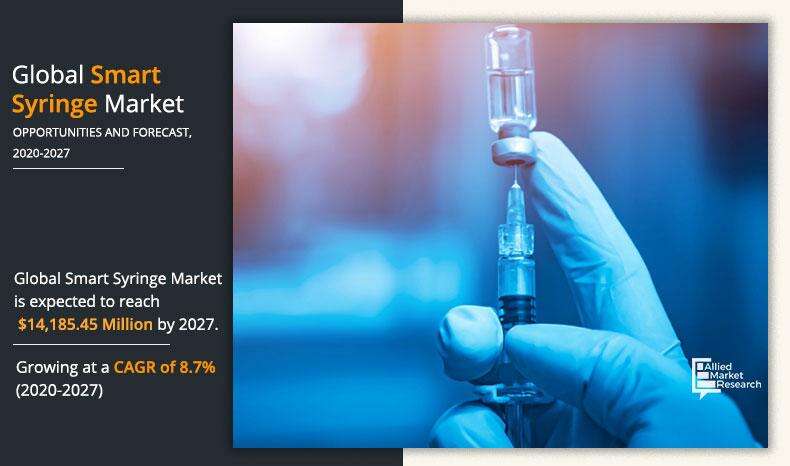Normal
0
false
false
false
EN-US
X-NONE
X-NONE
/* Style Definitions */
table.MsoNormalTable
{mso-style-name:”Table Normal”;
mso-tstyle-rowband-size:0;
mso-tstyle-colband-size:0;
mso-style-noshow:yes;
mso-style-priority:99;
mso-style-qformat:yes;
mso-style-parent:””;
mso-padding-alt:0cm 5.4pt 0cm 5.4pt;
mso-para-margin-top:0cm;
mso-para-margin-right:0cm;
mso-para-margin-bottom:10.0pt;
mso-para-margin-left:0cm;
line-height:115%;
mso-pagination:widow-orphan;
font-size:11.0pt;
font-family:”Calibri”,”sans-serif”;
mso-ascii-font-family:Calibri;
mso-ascii-theme-font:minor-latin;
mso-fareast-font-family:”Times New Roman”;
mso-fareast-theme-font:minor-fareast;
mso-hansi-font-family:Calibri;
mso-hansi-theme-font:minor-latin;
mso-bidi-font-family:”Times New Roman”;
mso-bidi-theme-font:minor-bidi;}
Global Smart Syringes Market Insights
Global Smart Syringes Market size was valued at USD 7.84 billion in 2021 and is poised to grow from USD 8.45 billion in 2022 to USD 15.41 billion by 2030, growing at a CAGR of 7.8% in the forecast period (2023-2030).
Syringes are medical devices used to inject fluid or withdraw fluid from the body. A medical syringe consists of a needle attached to a hollow cylinder fitted with a sliding piston. The World Health Organization observes unsafe syringe use around the world, leading to widespread infection among health workers and patients. Unsafe syringe use can cause abscesses, septicaemia, and nerve damage, and also in severe cases, haemorrhagic fevers and malaria are transmitted. Smart syringes are equipped with features that prevent needle stick injuries to the person using these syringes and prevent the transmission of blood-borne diseases such as hepatitis C virus, hepatitis B virus, and human immunodeficiency virus. They target numerous applications that include vaccination, drug delivery, and blood sampling.
Smart syringes perfectly address the need for safe injection practices by eliminating the reuse of syringes. So, the growing demand for minimally invasive procedures among the population is driving the demand for smart syringes. Smart syringes prevent needle stick injuries associated with traditional injections. Recommendations from the World Health Organization to adopt the use of smart syringes to prevent needle stick injuries and promote good injection practices worldwide are driving the growth of the global syringes market. The rising prevalence of blood-borne diseases due to unsafe injection practices has significantly boosted the growth of the global smart syringes market. The increasing incidence of chronic diseases and viral infections among the general population is one of the major reasons driving the global demand for smart syringes. It may also be due to an aging population that is more susceptible to serious medical problems. Additionally, increased demand for self-injecting drugs is driving market expansion.
Smart syringes are more expensive than conventional syringes, making global adoption difficult. Some are less expensive than single-use syringes. Others, depending on the technological advancement of the security systems, can cost up to five times more than others, making them expensive in some low- and middle-income nations, hampering the market growth.
Global Smart Syringes Market Segmental Analysis
Global smart syringes market is segmented on the basis of product, application, age group, end user, and region. On the basis of product, global smart syringes market is segmented into auto-disable syringes, active safety syringes, and passive safety syringes. On the basis of application, global smart syringes market is segmented into drug delivery, vaccination, and blood specimen collection. By age group, the Smart Syringes Market is segmented into Pediatrics and Adults. By End User, the Smart Syringes Market is segmented into Hospitals and HMOs, Diabetic Patients, Family Practices, Psychiatrics, and Others. On the basis of region, global smart syringes market is divided into North America, Europe, Asia Pacific and MEA.
Smart Syringes Market Analysis by Product
On the basis of product, global smart syringes market is segmented into auto-disable syringes, active safety syringes, and passive safety syringes. Auto-disable syringes segment has about 64% market share and is expected to grow at a significant CAGR during the forecast period. Auto-disable syringes are the most popular type of smart syringe in hospitals and healthcare institutions, as they are single-use syringes that cannot be reused. Widespread use of self-sterilizing syringes in daily drug delivery to patients. The safety mechanism of this syringe prevents the spread of blood-borne infections, thus meeting the most important need for a smart syringe.
The passive safety syringe segment is expected to be the most competitive. The growth of this segment is expected to be driven by greater safety, the self-activation of safety features, and the convenience associated with the use of passive safety syringes. Growing awareness about the benefits of passive safety syringes among the diabetic community is expected to drive global demand.
Smart Syringes Market Analysis by Application
On the basis of application, global smart syringes market is segmented into drug delivery, vaccination, and blood specimen collection. The global smart syringe market is dominated by the drug delivery segment. The growing use of smart syringes as drug delivery devices in hospitals and clinics has increased the demand for smart syringes. The increasing number of various chronic diseases is increasing the use of smart syringes as a better tool for drug administration and higher drug absorption through injection, which is driving the growth of this segment.
The vaccination segment is expected to be the fastest-growing segment during the forecast period. The increasing global burden of infectious diseases coupled with continuous research and development operations of vaccine manufacturing companies is expected to drive the growth of this segment.


